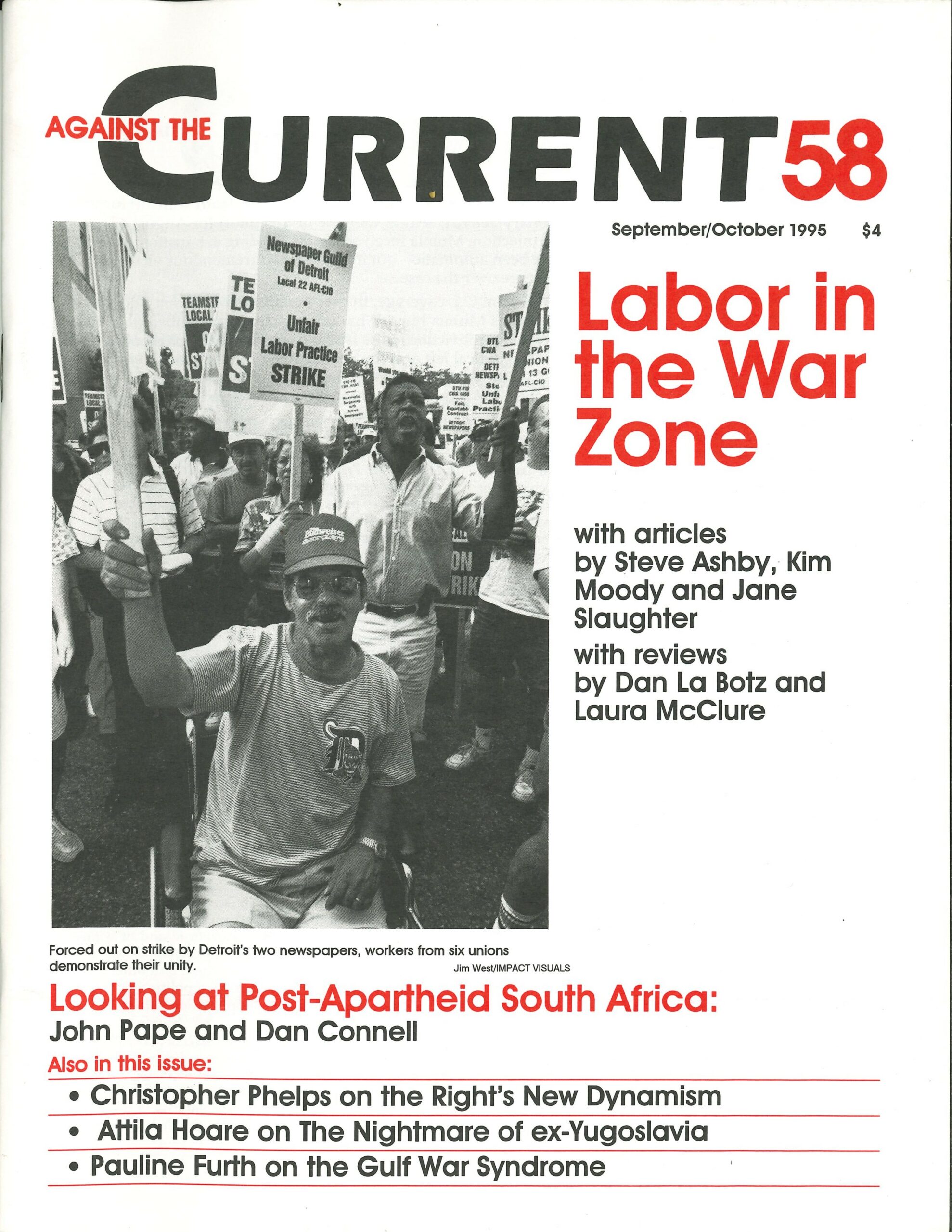Against the Current, No. 58, September/October 1995
-
Save Mumia Abu-Jamal
— The Editors -
The Right's New Dynamism
— Christopher Phelps -
The Pseudo-Science: Creationism
— Christopher Phelps -
The Gulf War Syndrome Mystery
— Pauline Furth, M.D. -
Britain: Conservatives Collapse & Labor Lurches Right
— Harry Brighouse -
Can Bosnia Resist?
— Attila Hoare -
Radical Rhythms: "Dancing on John Wayne's Head"
— John Greenbaum -
Rebel Girl: Murder, the Double Standard
— Catherine Sameh -
Random Shots: Kampfer, Eat Like Him
— R.F. Kampfer - Labor in the War Zone
-
June 25th in Decatur
— Steve Ashby -
Staley Workers Vote to Fight On
— Steve Ashby -
Why the Industrial Working Class Still Matters
— Kim Moody -
The New American Workplace
— Jane Slaughter -
Review: Working Smart
— Laura McClure -
Review: The CIO 1935-1955
— Dan La Botz - Post Apartheid South Africa
-
A Note of Introduction
— The Editors -
Year One of the Transition
— John Pape -
What's Left of the Grassroots Left?
— Dan Connell - Reviews
-
Serbia's Flawed Liberal Opposition
— Attila Hoare - Dialogue on American Trotskyism
-
A Reply to Alan Wald
— Steve Bloom -
Our Legacy: A Reply to Critics
— Alan Wald - Letters to Against the Current
-
On "Closing the Courthouse Doors"
— Barbara Zeluck
Catherine Sameh
THERE IS NO doubt the memory of Nicole Brown Simpson will never be enshrined in quite the same way as that of Michael and Alex Smith. So accustomed to the extinction of women’s lives at the hands of men, and simultaneously so hesitant to hold men accountable for their crimes, we have extended O.J. Simpson an extraordinary degree of empathy.
As for Susan Smith, a mother who killed her children in a society that idealizes motherhood and children, any complexity of analysis of her motives or shred of compassion for her has either been expressed through fundamentally narrow and patronizing categories, or completely eclipsed by the intense emotion surrounded the death of the boys.
Smith’s blaming of an African-American man for her sons’ deaths before finally admitting to the crime herself was so racist and mean spirited, it’s understandable that there would be a tremendous amount of anger towards her, particularly in the African-American community. How many men in the African-American community were hauled in as suspects because of her attempt to cover up her crime by blaming a Black man?
While there’s no question that Susan Smith is guilty of the act–and has just been sentenced to life imprisonment–the popular desire to see her pay with her life did not signify concern and nurturing for children. Rather, our rush to sentence her, and bury any real public discussion of what led her to this act, indicates a profound anxiety about women who so dramatically express ambivalence, through mental or physical violence, or murder, about their children. We simply cannot and will not try to understand.
The slight concern that was displayed for Smith came through the construction of a defense based exclusively on seeing her through the lens of sexual abuse victim. And while there is no doubt that her longtime sexual molestation by her stepfather—a leader, as it happens, in the Christian Coalition in South Carolina–left irreparable damage, that explanation alone robs both Smith and the American public of a frank and nuanced understanding of the multiple factors in this culture that damage women so profoundly.
It is now widely known that Smith was in love with Tom Findlay, the rich son of her rich boss. And that Findlay, days before Smith’s act, ended their relationship because he wanted neither a long-term commitment nor her children. It is also wisely known and even discussed that Smith was financially strapped, raising two kids on $17,000.
But instead of offering her any real sympathy as a victim of economic oppression, mass reportage and public response have viewed Smith as manipulative and selfish, classic terms of derision for working-class women who do whatever it takes to lift themselves out of poverty.
As the brutality of American life deepens, the most macabre criminal acts continue to flourish. They cannot be easily understood. What we must expand are our ways of understanding what drives people to such craziness, the systemic violence that kills not in one dramatic act, but daily, viciously, most intentionally.
ATC 58, September-October 1995

